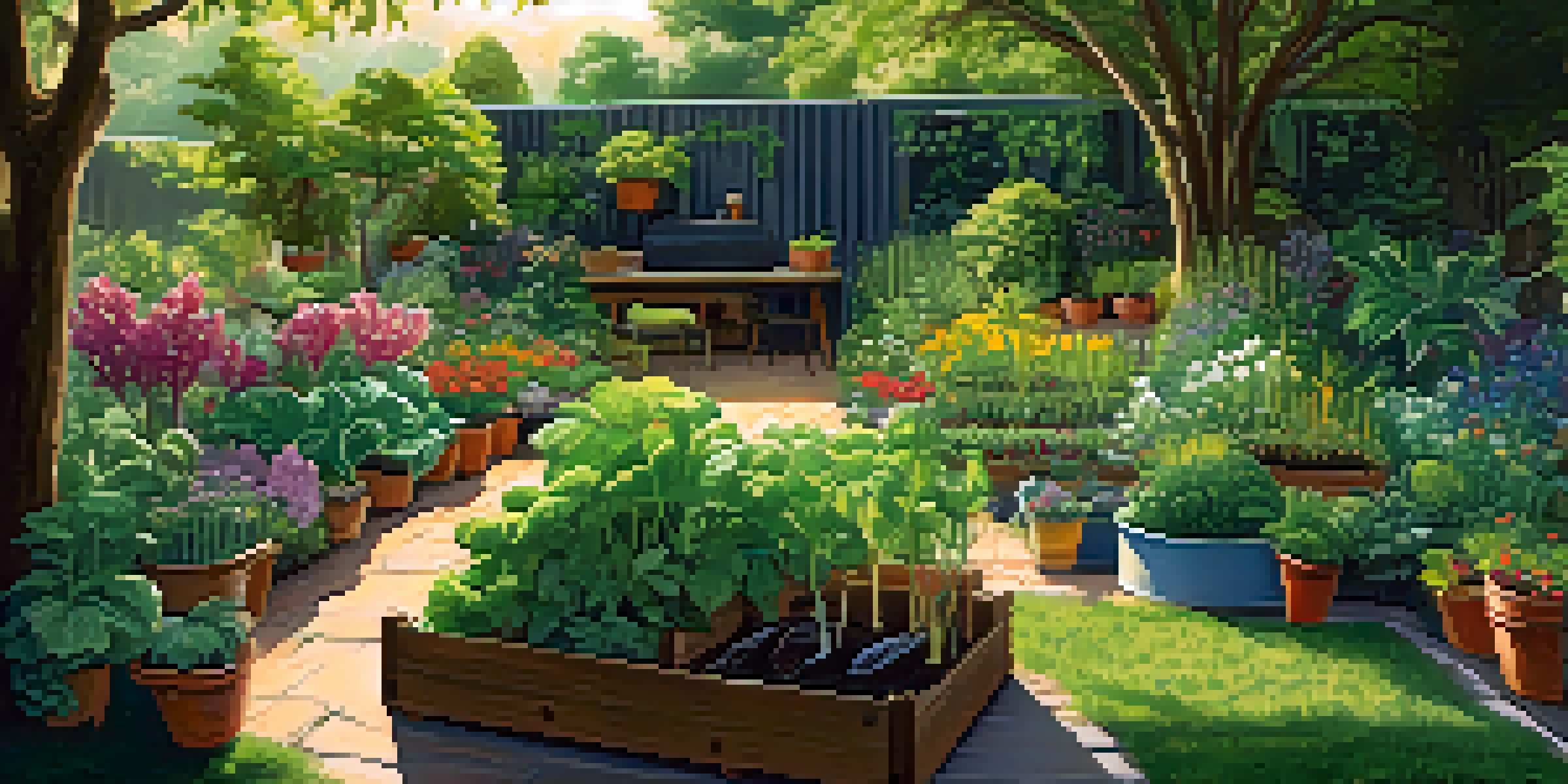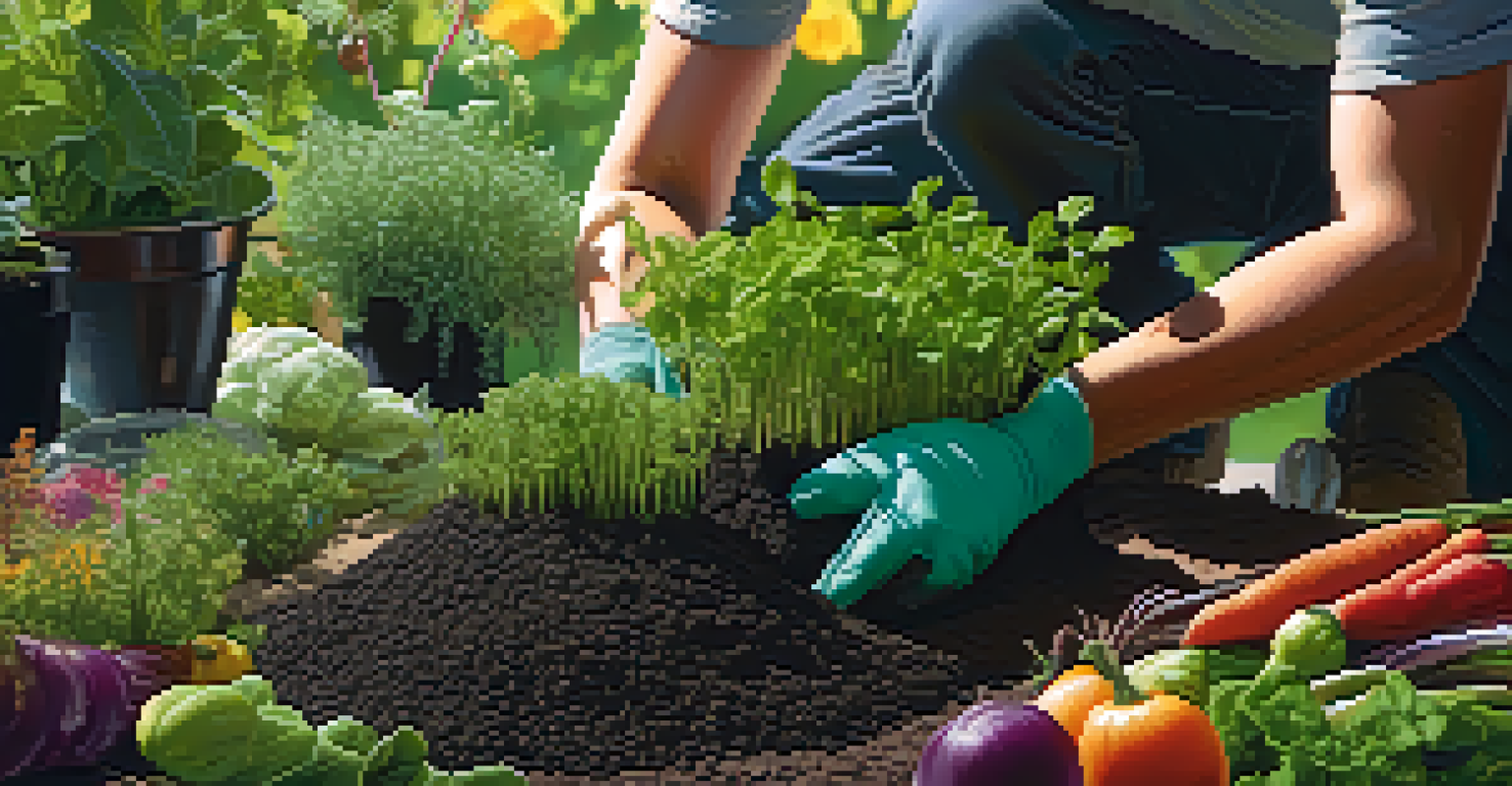Permaculture Principles: Design a Sustainable Garden Ecosystem

Understanding Permaculture: A Holistic Approach to Gardening
Permaculture is more than just gardening; it's a philosophy that promotes sustainable living by working with nature. It emphasizes creating systems that mimic natural ecosystems, ensuring that your garden is both productive and resilient. By observing how plants, animals, and natural processes interact, you can design a garden that thrives with minimal intervention.
The greatest threat to our planet is the belief that someone else will save it.
At its core, permaculture focuses on the interconnections between different elements in your garden. For example, planting companion plants can enhance growth and deter pests naturally. This not only leads to a healthier garden but also fosters biodiversity, which is crucial for a stable ecosystem.
By understanding and implementing permaculture principles, you can create a space that not only provides food but also supports wildlife, improves soil health, and conserves water. This holistic approach can transform your garden into a vibrant ecosystem that benefits both you and the environment.
The Principle of Observe and Interact: Know Your Space
The first principle of permaculture urges gardeners to observe their environment closely before making changes. This means taking the time to understand the sunlight, water flow, and existing plant life in your garden space. By doing so, you can identify what works well and what needs improvement.

For instance, if you notice that certain areas of your garden receive more sunlight than others, you can strategically plant sun-loving vegetables in those spots. Similarly, understanding how water drains during rainfall can help you design effective swales or rain gardens to capture and utilize water efficiently.
Permaculture Promotes Sustainable Living
This holistic approach to gardening works with nature to create resilient ecosystems that benefit both plants and wildlife.
This principle encourages a relationship with your garden, allowing you to adapt and respond to its unique needs. By interacting with your space thoughtfully, you can create a garden that flourishes naturally, reducing the need for artificial inputs.
Catch and Store Energy: Utilizing Natural Resources
In permaculture, capturing and storing energy is about maximizing the resources available to you. This could mean using rain barrels to collect rainwater or planting trees that provide shade and windbreaks. Both practices help create a more sustainable garden by reducing reliance on external water and energy sources.
Permaculture is a philosophy of working with, rather than against nature.
For example, using solar panels to power garden lights or tools can lower your energy costs while reducing your carbon footprint. Additionally, composting kitchen scraps not only provides valuable nutrients for your soil but also helps reduce waste.
By thinking creatively about how to capture and store energy, you can make your garden more self-sufficient. This principle not only enhances the sustainability of your garden but also allows you to make the most of what nature provides.
Obtain a Yield: Ensuring Productivity in Your Garden
One of the fundamental principles of permaculture is to ensure that your garden yields food, resources, and enjoyment. This means choosing plants that are not only beautiful but also provide tangible benefits, such as fruits, vegetables, or herbal remedies. A garden that produces a variety of yields can support your family and create a sense of fulfillment.
Consider implementing a diverse planting strategy that includes annual vegetables, perennial plants, and even edible flowers. This diversity can help ensure that something is always in season, maximizing your harvest. Plus, it can attract beneficial insects and pollinators, which further enhances your garden's productivity.
Observe and Adapt to Your Garden
By closely observing your garden's unique conditions, you can make informed decisions that enhance its health and productivity.
By focusing on obtaining yields, you create a garden that not only nourishes you but also contributes to the ecosystem. This interconnectedness fosters a sense of responsibility and connection to your food sources, enriching your life in more ways than one.
Apply Self-Regulation and Accept Feedback: Learn and Adapt
In permaculture, self-regulation means being mindful of your practices and their impact on the environment. This principle encourages you to evaluate your gardening methods and be open to change. If a certain approach isn't yielding the desired results, it's essential to learn from the experience and adapt accordingly.
For example, if a particular crop is struggling, rather than forcing it to grow, you might consider rotating it with another plant that thrives better in your conditions. This flexibility allows your garden to evolve and improve over time, leading to greater success and sustainability.
Accepting feedback from your garden—whether it's through observing plant health or pest populations—helps you refine your methods. This principle fosters a dynamic relationship with your garden, promoting resilience and ongoing learning as you grow.
Use and Value Renewable Resources: Sustainability at Its Best
This principle emphasizes the importance of utilizing renewable resources to create a sustainable garden ecosystem. Using materials that can be replenished, like compost, rainwater, and native plants, not only conserves resources but also minimizes waste. This approach allows you to work with nature rather than against it.
For instance, incorporating perennial plants that return year after year reduces the need for replanting, saving time and effort. Additionally, using organic mulch can help retain moisture in the soil while suppressing weeds, further enhancing sustainability.
Integrate for Maximum Efficiency
Creating connections between plants and animals in your garden fosters a symbiotic environment that maximizes resources and minimizes waste.
By valuing renewable resources, you create a garden that thrives without depleting the environment. This practice not only benefits your garden but also encourages a lifestyle that respects and nurtures the planet.
Integrate Rather Than Segregate: Creating Connections
Permaculture teaches us to integrate various elements of the garden to create a cohesive and efficient system. This means thinking about how different plants, animals, and features can work together to support one another. For example, planting nitrogen-fixing plants alongside heavy feeders can enhance soil fertility and reduce the need for chemical fertilizers.
Another great example is incorporating chickens into your garden. They can help control pests while providing valuable manure that enriches the soil. By integrating these elements, you create a symbiotic environment where everything has a role to play.

This principle encourages a holistic view of your garden as an interconnected ecosystem. By fostering these relationships, you can create a thriving space that maximizes productivity and minimizes waste.
Design from Patterns to Details: The Big Picture Approach
The final principle of permaculture highlights the importance of understanding the broader patterns in nature before diving into the details of your garden design. By recognizing natural patterns—like the way water flows, sunlight moves, and seasons change—you can create a garden that harmonizes with these rhythms.
For instance, when designing your garden layout, consider the overall shape of your space and how plants will interact within it. Observing existing patterns can help you decide where to place larger trees for shade or where to create raised beds that capture rainwater.
Thinking from patterns to details allows for a more intuitive design that flows with nature. This approach not only enhances the beauty of your garden but also ensures that it functions effectively as a sustainable ecosystem.